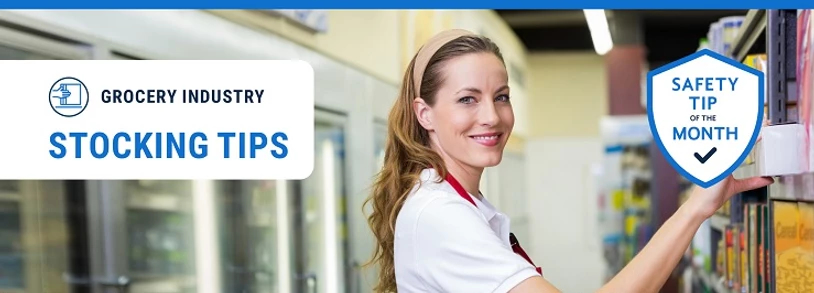Running a retail store requires juggling multiple responsibilities, and ensuring the safety of your employees and customers is one of the most important. It only takes a split second for a customer or employee to slip on a wet floor, trip over an obstacle, fall, and suffer an injury. And that’s the first step toward a potentially costly workers’ compensation claim or liability suit.
Slip, trip, and fall hazards can be created by the most mundane activities, even the mere act of stocking shelves. So it’s crucial to train your staff in safe stocking procedures to keep customers and workers safe from these hazards.
Risks For Your Customers
We’ve all gone into a grocery or other retail store and had to navigate around pallets, carts, boxes, or other obvious signs of shelves being stocked. These scenarios can create multiple hazards. A customer can easily slip on a wet surface caused by spilled product or even moisture dripping off produce or other products. They could trip over an empty box or a cart and fall. That’s just the kind of scenario that can invite a costly liability claim.
Risks For Your Employees
Your workers face many of the same hazards as your customers when stocking shelves, and slips, trips, and falls are the leading cause of workplace accidents and workers’ compensation claims. They also cause 15 percent of all accidental deaths according to OSHA.
Prevention Starts With A Plan
As a business owner, you have a legal responsibility to act prudently and use reasonable care in providing a safe place of business for customers and a safe work environment for employees, including during stocking operations. That takes a solid plan that includes:
- A written safety policy that outlines safe stocking procedures and expectations.
- Training and reinforcement in good housekeeping and safe stocking practices to help prevent slip and fall accidents.
- Regular monitoring of stocking operations to identify and remedy any hazards immediately.
- Implementing procedures to prevent future hazards.
10 Stocking Safety Tips
Follow these ten safety tips to help keep your employees and customers safe from slip, trip, and fall hazards during stocking operations.
1. Maintain good housekeeping on the sales floor and in the stock room to help prevent trips and falls.
2. Maintain clearance between rows and aisles on the sales floor and in the stock room to ensure there is adequate room around pallets and stacks of freight for customers and employees to safely maneuver around.
3. Immediately remove empty boxes, crates, and other debris from the sales floor after use.
4. Require employees to use a step stool or ladder to reach items on the top of pallets or high shelves, and immediately return stools, ladders, and carts to a designated storage area in the stockroom after use.
5. If product staging is required during the day, place product on the sales floor in stacks at least three feet high to increase visibility and prevent trips and falls.
6. During store hours transport product to the sales floor using stocking carts or hand trucks instead of a pallet.
7. If stocking must be done from a pallet, place the pallet in an open and low-traffic area of the sales floor, and never leave empty pallets on the sales floor.
8. Train your staff to continuously monitor for and immediately remove any obstructions and clean up any potentially slippery spills.
9. Use highly visible cones, tape, or other markers to alert customers of an obstruction or spill in the stocking area while it’s being cleaned up.
10. Document everything, including all preemptive measures, safety procedures, training, and regular store walk-arounds.
Download our 10 Stocking Safety Tips and regularly train and monitor your team to ensure best practices are followed during stocking operations. Need more risk management advice? Talk to the grocery insurance professionals at RiskPoint Insurance today.
| Joe Scarpello | Melissa Johnson |
| 253.444.5584 | 253.444.5654 |


